Analysing the Efficacy of Behavioural Change Models in Business Change
VerifiedAdded on 2020/06/04
|11
|2565
|197
Report
AI Summary
This report provides a critical comparison of the Michie, Van Stralen & West’s Behavioural Change Wheel/COM-B model with other change management models, such as Lewin's and Kotter's, for their efficacy in managing organisational change. The introduction highlights the importance of managing behavioural changes in response to market trends and consumer preferences. The main body delves into the COM-B model, explaining its components (capability, opportunity, and motivation) and its application in various contexts, particularly in public health. The report also analyses Kotter's change management model and Lewin's model, contrasting their approaches and effectiveness. The COM-B model's strengths lie in its detailed, systematic approach, while Kotter's model is recognized for its time-efficiency. The report also discusses the outer wheel of the COM-B model, which covers policy categories, guidelines, fiscal measures, regulation, service provision, legislation, and communication. The conclusion summarizes the findings, emphasizing the unique strategies and processing of each model in managing changes within organisations. The report provides valuable insights into the application and comparative advantages of these change management models.
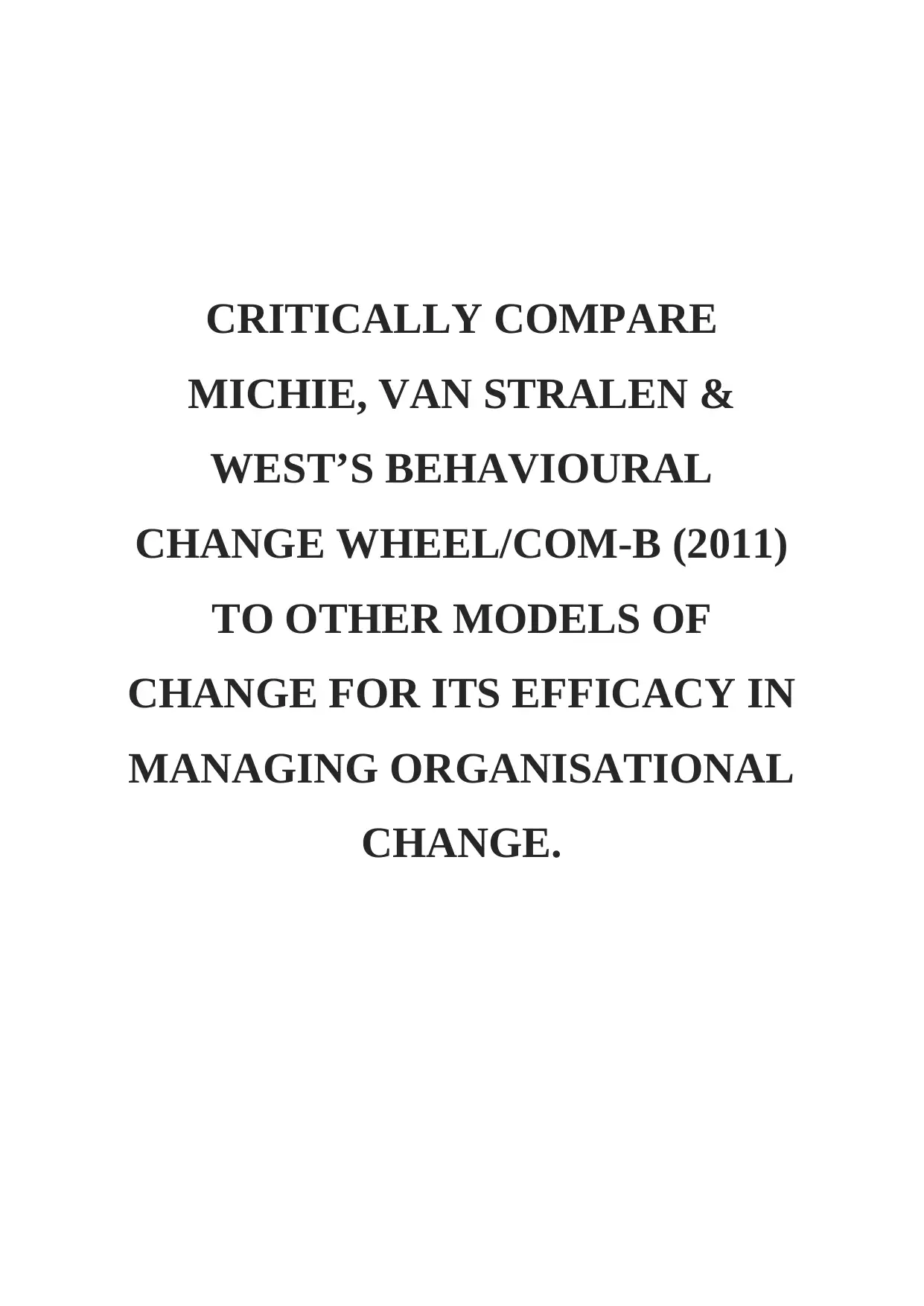
CRITICALLY COMPARE
MICHIE, VAN STRALEN &
WEST’S BEHAVIOURAL
CHANGE WHEEL/COM-B (2011)
TO OTHER MODELS OF
CHANGE FOR ITS EFFICACY IN
MANAGING ORGANISATIONAL
CHANGE.
MICHIE, VAN STRALEN &
WEST’S BEHAVIOURAL
CHANGE WHEEL/COM-B (2011)
TO OTHER MODELS OF
CHANGE FOR ITS EFFICACY IN
MANAGING ORGANISATIONAL
CHANGE.
Paraphrase This Document
Need a fresh take? Get an instant paraphrase of this document with our AI Paraphraser

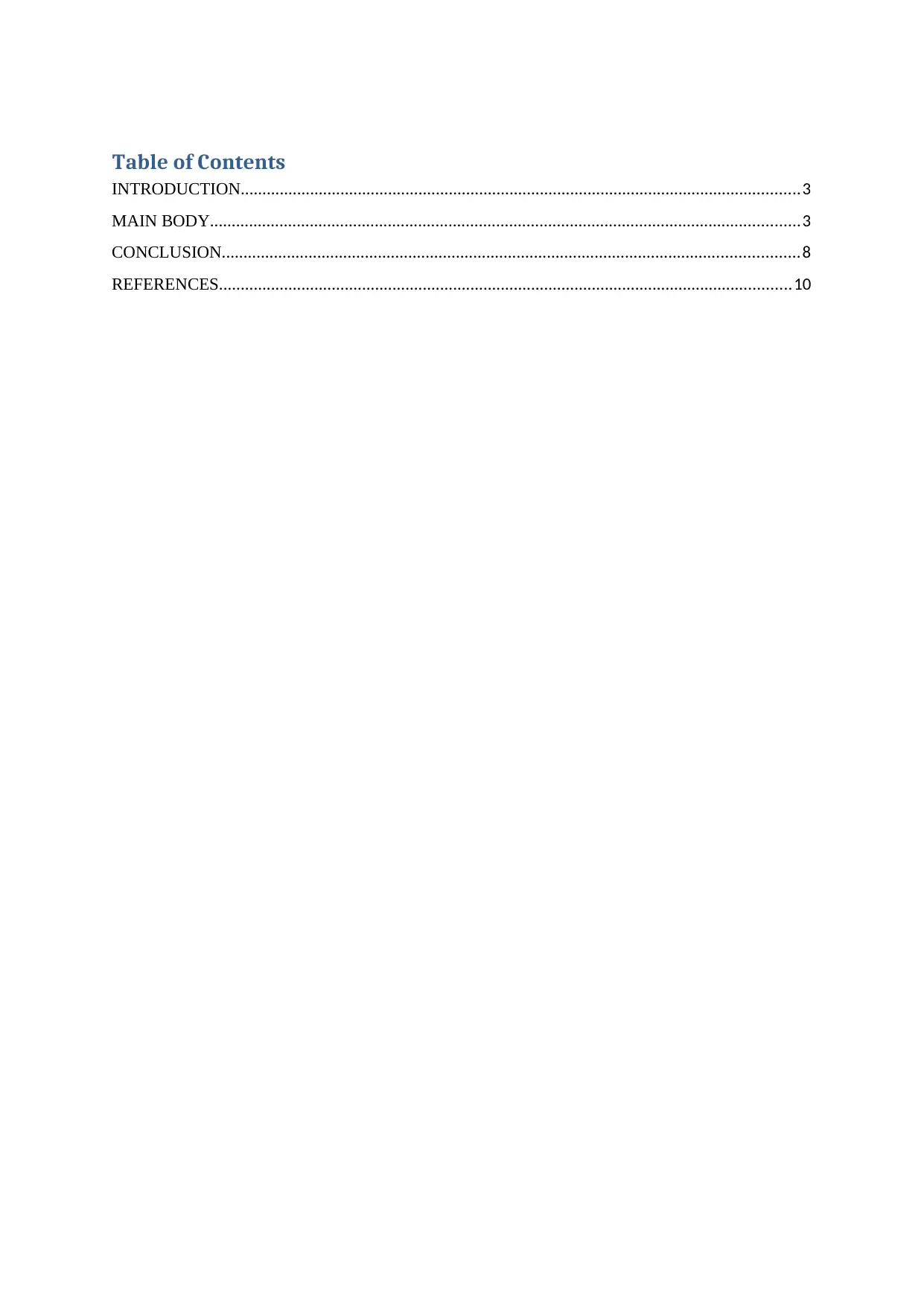
Table of Contents
INTRODUCTION.................................................................................................................................3
MAIN BODY........................................................................................................................................3
CONCLUSION.....................................................................................................................................8
REFERENCES....................................................................................................................................10
INTRODUCTION.................................................................................................................................3
MAIN BODY........................................................................................................................................3
CONCLUSION.....................................................................................................................................8
REFERENCES....................................................................................................................................10
⊘ This is a preview!⊘
Do you want full access?
Subscribe today to unlock all pages.

Trusted by 1+ million students worldwide
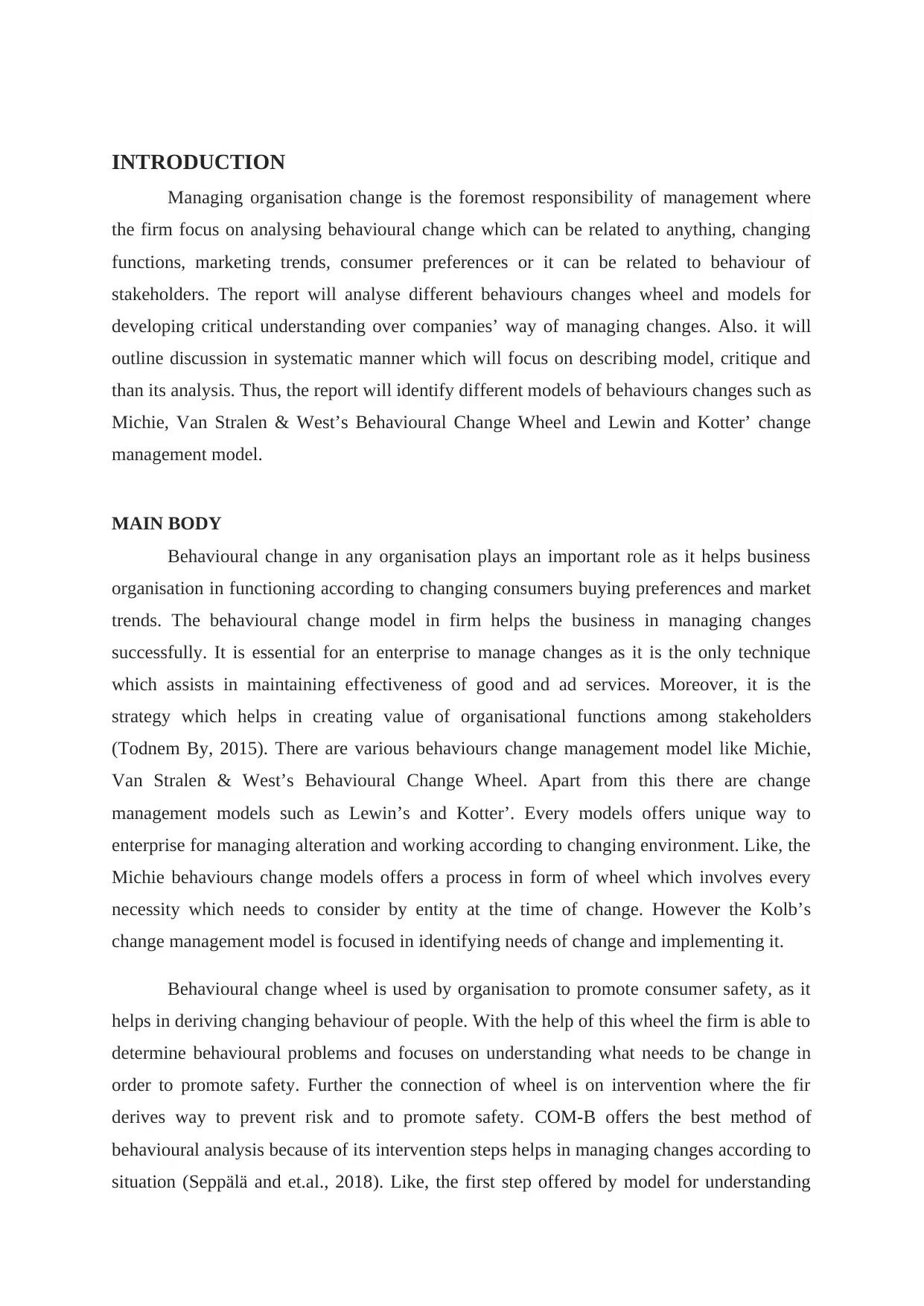
INTRODUCTION
Managing organisation change is the foremost responsibility of management where
the firm focus on analysing behavioural change which can be related to anything, changing
functions, marketing trends, consumer preferences or it can be related to behaviour of
stakeholders. The report will analyse different behaviours changes wheel and models for
developing critical understanding over companies’ way of managing changes. Also. it will
outline discussion in systematic manner which will focus on describing model, critique and
than its analysis. Thus, the report will identify different models of behaviours changes such as
Michie, Van Stralen & West’s Behavioural Change Wheel and Lewin and Kotter’ change
management model.
MAIN BODY
Behavioural change in any organisation plays an important role as it helps business
organisation in functioning according to changing consumers buying preferences and market
trends. The behavioural change model in firm helps the business in managing changes
successfully. It is essential for an enterprise to manage changes as it is the only technique
which assists in maintaining effectiveness of good and ad services. Moreover, it is the
strategy which helps in creating value of organisational functions among stakeholders
(Todnem By, 2015). There are various behaviours change management model like Michie,
Van Stralen & West’s Behavioural Change Wheel. Apart from this there are change
management models such as Lewin’s and Kotter’. Every models offers unique way to
enterprise for managing alteration and working according to changing environment. Like, the
Michie behaviours change models offers a process in form of wheel which involves every
necessity which needs to consider by entity at the time of change. However the Kolb’s
change management model is focused in identifying needs of change and implementing it.
Behavioural change wheel is used by organisation to promote consumer safety, as it
helps in deriving changing behaviour of people. With the help of this wheel the firm is able to
determine behavioural problems and focuses on understanding what needs to be change in
order to promote safety. Further the connection of wheel is on intervention where the fir
derives way to prevent risk and to promote safety. COM-B offers the best method of
behavioural analysis because of its intervention steps helps in managing changes according to
situation (Seppälä and et.al., 2018). Like, the first step offered by model for understanding
Managing organisation change is the foremost responsibility of management where
the firm focus on analysing behavioural change which can be related to anything, changing
functions, marketing trends, consumer preferences or it can be related to behaviour of
stakeholders. The report will analyse different behaviours changes wheel and models for
developing critical understanding over companies’ way of managing changes. Also. it will
outline discussion in systematic manner which will focus on describing model, critique and
than its analysis. Thus, the report will identify different models of behaviours changes such as
Michie, Van Stralen & West’s Behavioural Change Wheel and Lewin and Kotter’ change
management model.
MAIN BODY
Behavioural change in any organisation plays an important role as it helps business
organisation in functioning according to changing consumers buying preferences and market
trends. The behavioural change model in firm helps the business in managing changes
successfully. It is essential for an enterprise to manage changes as it is the only technique
which assists in maintaining effectiveness of good and ad services. Moreover, it is the
strategy which helps in creating value of organisational functions among stakeholders
(Todnem By, 2015). There are various behaviours change management model like Michie,
Van Stralen & West’s Behavioural Change Wheel. Apart from this there are change
management models such as Lewin’s and Kotter’. Every models offers unique way to
enterprise for managing alteration and working according to changing environment. Like, the
Michie behaviours change models offers a process in form of wheel which involves every
necessity which needs to consider by entity at the time of change. However the Kolb’s
change management model is focused in identifying needs of change and implementing it.
Behavioural change wheel is used by organisation to promote consumer safety, as it
helps in deriving changing behaviour of people. With the help of this wheel the firm is able to
determine behavioural problems and focuses on understanding what needs to be change in
order to promote safety. Further the connection of wheel is on intervention where the fir
derives way to prevent risk and to promote safety. COM-B offers the best method of
behavioural analysis because of its intervention steps helps in managing changes according to
situation (Seppälä and et.al., 2018). Like, the first step offered by model for understanding
Paraphrase This Document
Need a fresh take? Get an instant paraphrase of this document with our AI Paraphraser
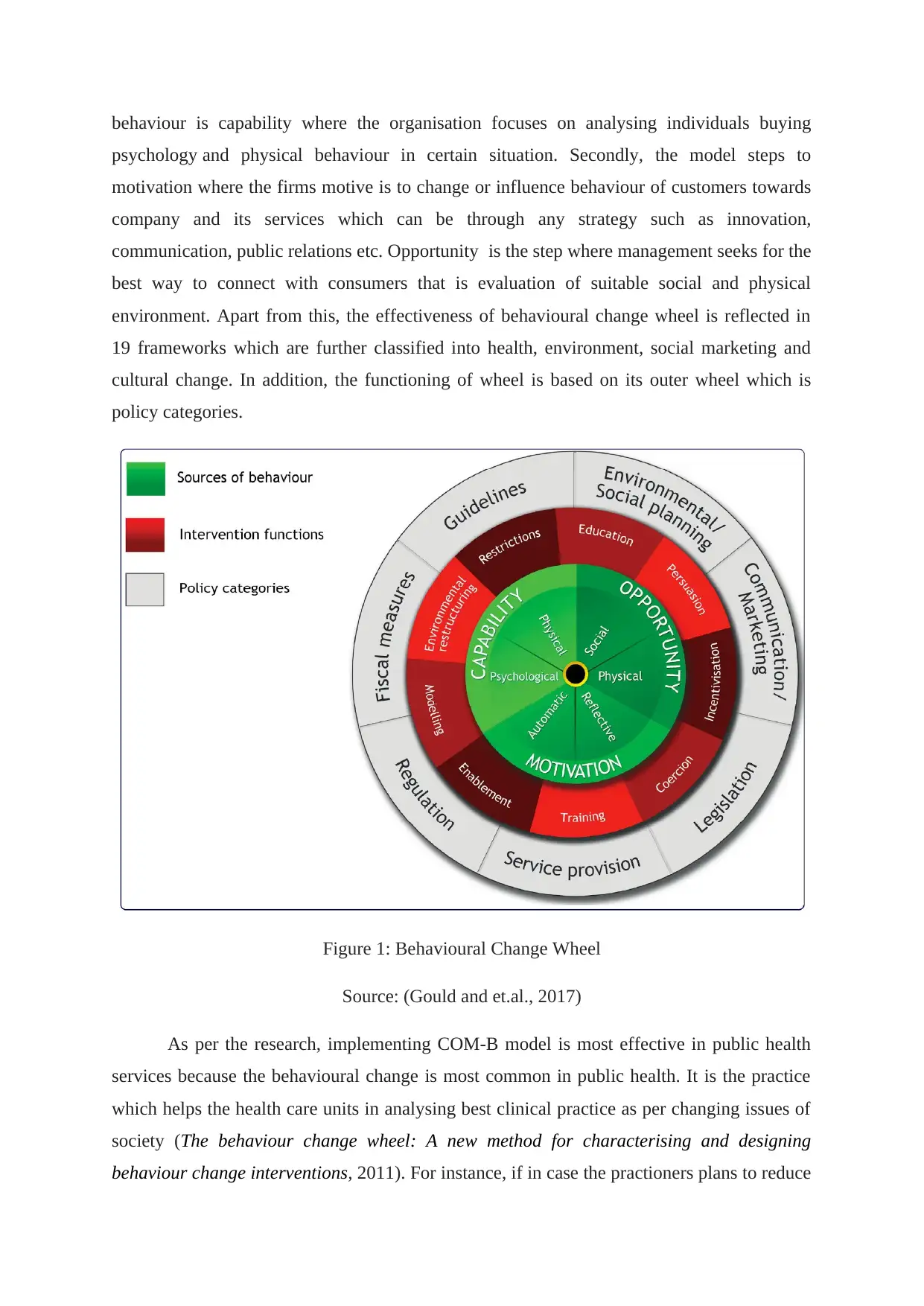
behaviour is capability where the organisation focuses on analysing individuals buying
psychology and physical behaviour in certain situation. Secondly, the model steps to
motivation where the firms motive is to change or influence behaviour of customers towards
company and its services which can be through any strategy such as innovation,
communication, public relations etc. Opportunity is the step where management seeks for the
best way to connect with consumers that is evaluation of suitable social and physical
environment. Apart from this, the effectiveness of behavioural change wheel is reflected in
19 frameworks which are further classified into health, environment, social marketing and
cultural change. In addition, the functioning of wheel is based on its outer wheel which is
policy categories.
Figure 1: Behavioural Change Wheel
Source: (Gould and et.al., 2017)
As per the research, implementing COM-B model is most effective in public health
services because the behavioural change is most common in public health. It is the practice
which helps the health care units in analysing best clinical practice as per changing issues of
society (The behaviour change wheel: A new method for characterising and designing
behaviour change interventions, 2011). For instance, if in case the practioners plans to reduce
psychology and physical behaviour in certain situation. Secondly, the model steps to
motivation where the firms motive is to change or influence behaviour of customers towards
company and its services which can be through any strategy such as innovation,
communication, public relations etc. Opportunity is the step where management seeks for the
best way to connect with consumers that is evaluation of suitable social and physical
environment. Apart from this, the effectiveness of behavioural change wheel is reflected in
19 frameworks which are further classified into health, environment, social marketing and
cultural change. In addition, the functioning of wheel is based on its outer wheel which is
policy categories.
Figure 1: Behavioural Change Wheel
Source: (Gould and et.al., 2017)
As per the research, implementing COM-B model is most effective in public health
services because the behavioural change is most common in public health. It is the practice
which helps the health care units in analysing best clinical practice as per changing issues of
society (The behaviour change wheel: A new method for characterising and designing
behaviour change interventions, 2011). For instance, if in case the practioners plans to reduce
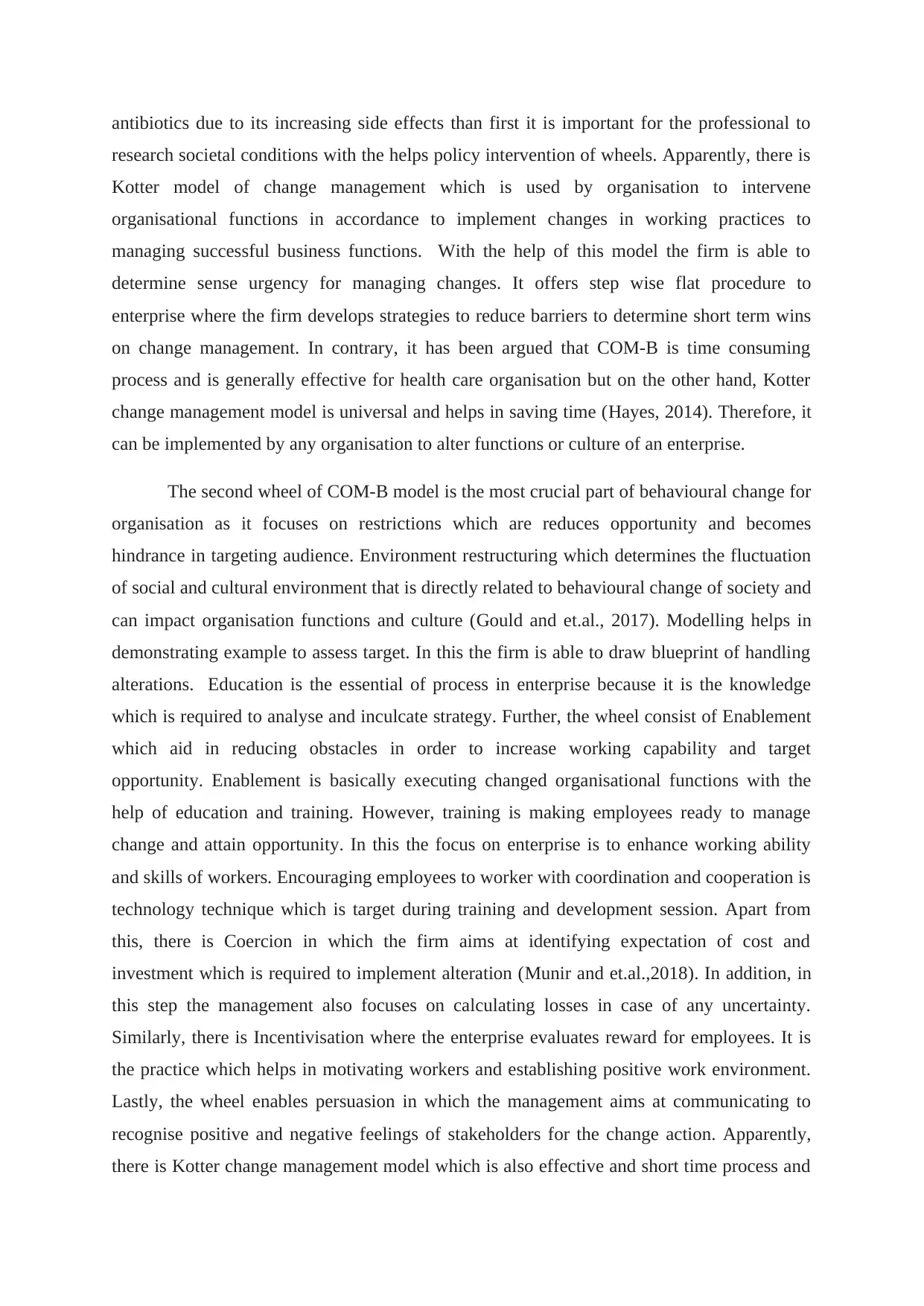
antibiotics due to its increasing side effects than first it is important for the professional to
research societal conditions with the helps policy intervention of wheels. Apparently, there is
Kotter model of change management which is used by organisation to intervene
organisational functions in accordance to implement changes in working practices to
managing successful business functions. With the help of this model the firm is able to
determine sense urgency for managing changes. It offers step wise flat procedure to
enterprise where the firm develops strategies to reduce barriers to determine short term wins
on change management. In contrary, it has been argued that COM-B is time consuming
process and is generally effective for health care organisation but on the other hand, Kotter
change management model is universal and helps in saving time (Hayes, 2014). Therefore, it
can be implemented by any organisation to alter functions or culture of an enterprise.
The second wheel of COM-B model is the most crucial part of behavioural change for
organisation as it focuses on restrictions which are reduces opportunity and becomes
hindrance in targeting audience. Environment restructuring which determines the fluctuation
of social and cultural environment that is directly related to behavioural change of society and
can impact organisation functions and culture (Gould and et.al., 2017). Modelling helps in
demonstrating example to assess target. In this the firm is able to draw blueprint of handling
alterations. Education is the essential of process in enterprise because it is the knowledge
which is required to analyse and inculcate strategy. Further, the wheel consist of Enablement
which aid in reducing obstacles in order to increase working capability and target
opportunity. Enablement is basically executing changed organisational functions with the
help of education and training. However, training is making employees ready to manage
change and attain opportunity. In this the focus on enterprise is to enhance working ability
and skills of workers. Encouraging employees to worker with coordination and cooperation is
technology technique which is target during training and development session. Apart from
this, there is Coercion in which the firm aims at identifying expectation of cost and
investment which is required to implement alteration (Munir and et.al.,2018). In addition, in
this step the management also focuses on calculating losses in case of any uncertainty.
Similarly, there is Incentivisation where the enterprise evaluates reward for employees. It is
the practice which helps in motivating workers and establishing positive work environment.
Lastly, the wheel enables persuasion in which the management aims at communicating to
recognise positive and negative feelings of stakeholders for the change action. Apparently,
there is Kotter change management model which is also effective and short time process and
research societal conditions with the helps policy intervention of wheels. Apparently, there is
Kotter model of change management which is used by organisation to intervene
organisational functions in accordance to implement changes in working practices to
managing successful business functions. With the help of this model the firm is able to
determine sense urgency for managing changes. It offers step wise flat procedure to
enterprise where the firm develops strategies to reduce barriers to determine short term wins
on change management. In contrary, it has been argued that COM-B is time consuming
process and is generally effective for health care organisation but on the other hand, Kotter
change management model is universal and helps in saving time (Hayes, 2014). Therefore, it
can be implemented by any organisation to alter functions or culture of an enterprise.
The second wheel of COM-B model is the most crucial part of behavioural change for
organisation as it focuses on restrictions which are reduces opportunity and becomes
hindrance in targeting audience. Environment restructuring which determines the fluctuation
of social and cultural environment that is directly related to behavioural change of society and
can impact organisation functions and culture (Gould and et.al., 2017). Modelling helps in
demonstrating example to assess target. In this the firm is able to draw blueprint of handling
alterations. Education is the essential of process in enterprise because it is the knowledge
which is required to analyse and inculcate strategy. Further, the wheel consist of Enablement
which aid in reducing obstacles in order to increase working capability and target
opportunity. Enablement is basically executing changed organisational functions with the
help of education and training. However, training is making employees ready to manage
change and attain opportunity. In this the focus on enterprise is to enhance working ability
and skills of workers. Encouraging employees to worker with coordination and cooperation is
technology technique which is target during training and development session. Apart from
this, there is Coercion in which the firm aims at identifying expectation of cost and
investment which is required to implement alteration (Munir and et.al.,2018). In addition, in
this step the management also focuses on calculating losses in case of any uncertainty.
Similarly, there is Incentivisation where the enterprise evaluates reward for employees. It is
the practice which helps in motivating workers and establishing positive work environment.
Lastly, the wheel enables persuasion in which the management aims at communicating to
recognise positive and negative feelings of stakeholders for the change action. Apparently,
there is Kotter change management model which is also effective and short time process and
⊘ This is a preview!⊘
Do you want full access?
Subscribe today to unlock all pages.

Trusted by 1+ million students worldwide
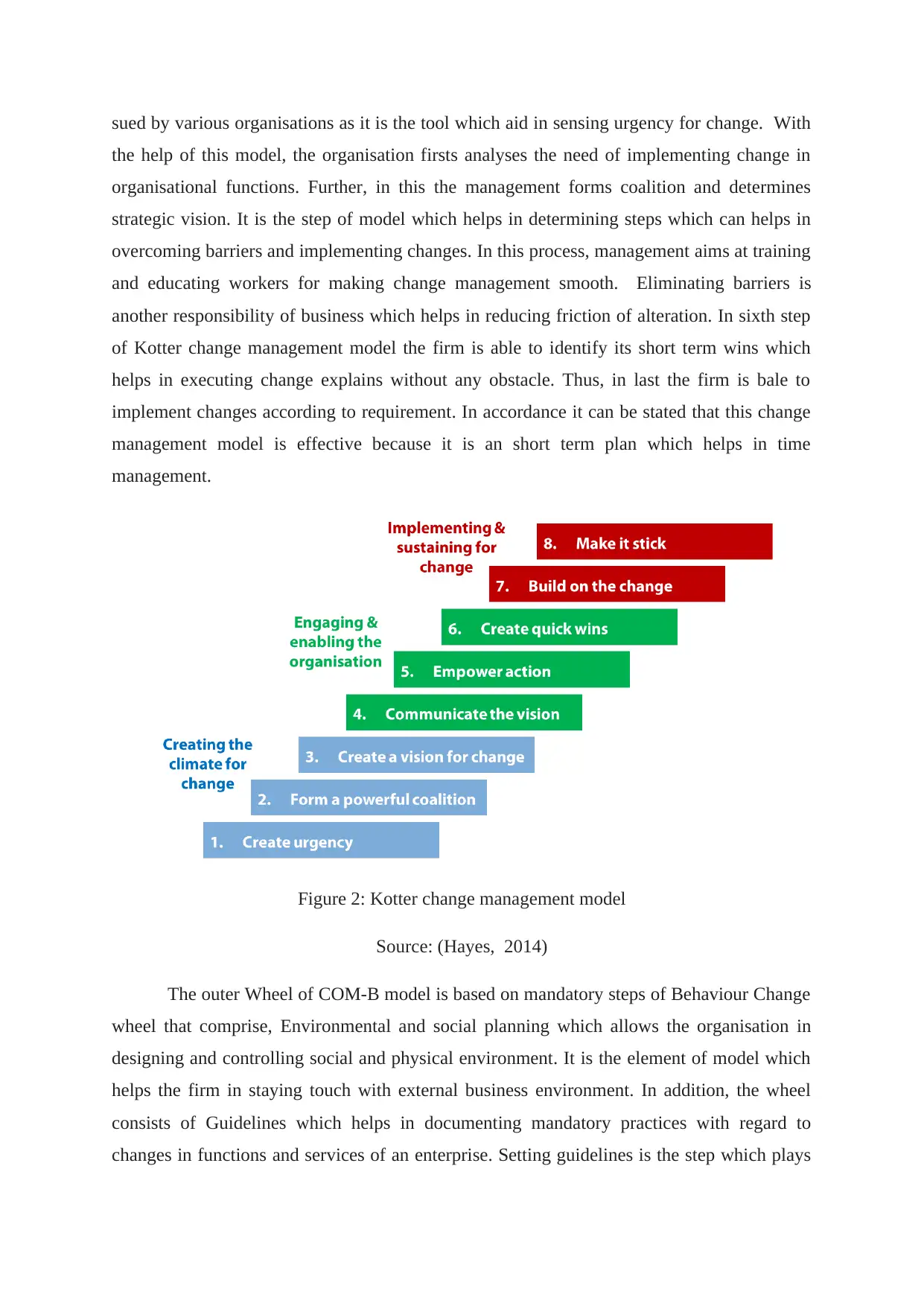
sued by various organisations as it is the tool which aid in sensing urgency for change. With
the help of this model, the organisation firsts analyses the need of implementing change in
organisational functions. Further, in this the management forms coalition and determines
strategic vision. It is the step of model which helps in determining steps which can helps in
overcoming barriers and implementing changes. In this process, management aims at training
and educating workers for making change management smooth. Eliminating barriers is
another responsibility of business which helps in reducing friction of alteration. In sixth step
of Kotter change management model the firm is able to identify its short term wins which
helps in executing change explains without any obstacle. Thus, in last the firm is bale to
implement changes according to requirement. In accordance it can be stated that this change
management model is effective because it is an short term plan which helps in time
management.
Figure 2: Kotter change management model
Source: (Hayes, 2014)
The outer Wheel of COM-B model is based on mandatory steps of Behaviour Change
wheel that comprise, Environmental and social planning which allows the organisation in
designing and controlling social and physical environment. It is the element of model which
helps the firm in staying touch with external business environment. In addition, the wheel
consists of Guidelines which helps in documenting mandatory practices with regard to
changes in functions and services of an enterprise. Setting guidelines is the step which plays
the help of this model, the organisation firsts analyses the need of implementing change in
organisational functions. Further, in this the management forms coalition and determines
strategic vision. It is the step of model which helps in determining steps which can helps in
overcoming barriers and implementing changes. In this process, management aims at training
and educating workers for making change management smooth. Eliminating barriers is
another responsibility of business which helps in reducing friction of alteration. In sixth step
of Kotter change management model the firm is able to identify its short term wins which
helps in executing change explains without any obstacle. Thus, in last the firm is bale to
implement changes according to requirement. In accordance it can be stated that this change
management model is effective because it is an short term plan which helps in time
management.
Figure 2: Kotter change management model
Source: (Hayes, 2014)
The outer Wheel of COM-B model is based on mandatory steps of Behaviour Change
wheel that comprise, Environmental and social planning which allows the organisation in
designing and controlling social and physical environment. It is the element of model which
helps the firm in staying touch with external business environment. In addition, the wheel
consists of Guidelines which helps in documenting mandatory practices with regard to
changes in functions and services of an enterprise. Setting guidelines is the step which plays
Paraphrase This Document
Need a fresh take? Get an instant paraphrase of this document with our AI Paraphraser
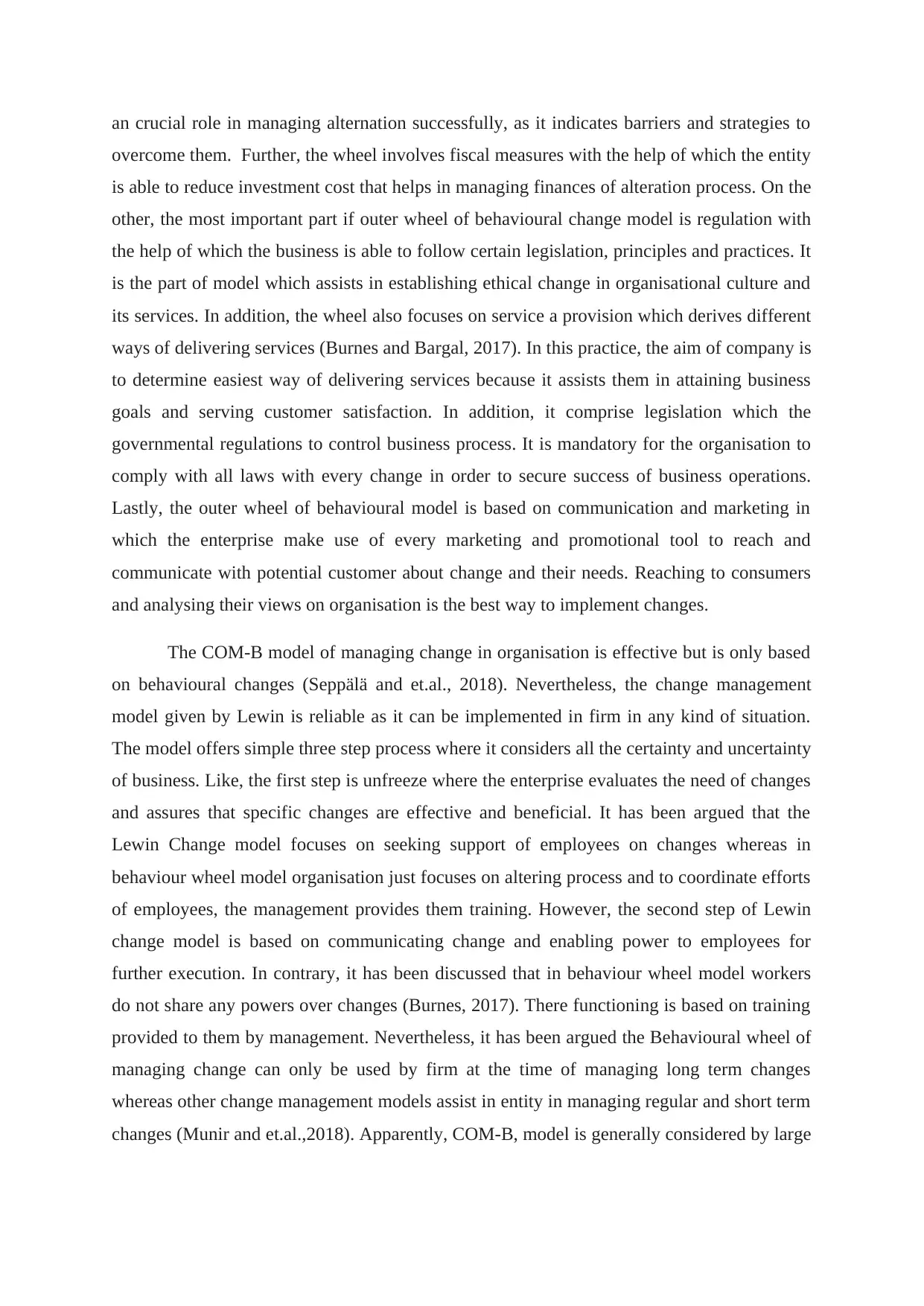
an crucial role in managing alternation successfully, as it indicates barriers and strategies to
overcome them. Further, the wheel involves fiscal measures with the help of which the entity
is able to reduce investment cost that helps in managing finances of alteration process. On the
other, the most important part if outer wheel of behavioural change model is regulation with
the help of which the business is able to follow certain legislation, principles and practices. It
is the part of model which assists in establishing ethical change in organisational culture and
its services. In addition, the wheel also focuses on service a provision which derives different
ways of delivering services (Burnes and Bargal, 2017). In this practice, the aim of company is
to determine easiest way of delivering services because it assists them in attaining business
goals and serving customer satisfaction. In addition, it comprise legislation which the
governmental regulations to control business process. It is mandatory for the organisation to
comply with all laws with every change in order to secure success of business operations.
Lastly, the outer wheel of behavioural model is based on communication and marketing in
which the enterprise make use of every marketing and promotional tool to reach and
communicate with potential customer about change and their needs. Reaching to consumers
and analysing their views on organisation is the best way to implement changes.
The COM-B model of managing change in organisation is effective but is only based
on behavioural changes (Seppälä and et.al., 2018). Nevertheless, the change management
model given by Lewin is reliable as it can be implemented in firm in any kind of situation.
The model offers simple three step process where it considers all the certainty and uncertainty
of business. Like, the first step is unfreeze where the enterprise evaluates the need of changes
and assures that specific changes are effective and beneficial. It has been argued that the
Lewin Change model focuses on seeking support of employees on changes whereas in
behaviour wheel model organisation just focuses on altering process and to coordinate efforts
of employees, the management provides them training. However, the second step of Lewin
change model is based on communicating change and enabling power to employees for
further execution. In contrary, it has been discussed that in behaviour wheel model workers
do not share any powers over changes (Burnes, 2017). There functioning is based on training
provided to them by management. Nevertheless, it has been argued the Behavioural wheel of
managing change can only be used by firm at the time of managing long term changes
whereas other change management models assist in entity in managing regular and short term
changes (Munir and et.al.,2018). Apparently, COM-B, model is generally considered by large
overcome them. Further, the wheel involves fiscal measures with the help of which the entity
is able to reduce investment cost that helps in managing finances of alteration process. On the
other, the most important part if outer wheel of behavioural change model is regulation with
the help of which the business is able to follow certain legislation, principles and practices. It
is the part of model which assists in establishing ethical change in organisational culture and
its services. In addition, the wheel also focuses on service a provision which derives different
ways of delivering services (Burnes and Bargal, 2017). In this practice, the aim of company is
to determine easiest way of delivering services because it assists them in attaining business
goals and serving customer satisfaction. In addition, it comprise legislation which the
governmental regulations to control business process. It is mandatory for the organisation to
comply with all laws with every change in order to secure success of business operations.
Lastly, the outer wheel of behavioural model is based on communication and marketing in
which the enterprise make use of every marketing and promotional tool to reach and
communicate with potential customer about change and their needs. Reaching to consumers
and analysing their views on organisation is the best way to implement changes.
The COM-B model of managing change in organisation is effective but is only based
on behavioural changes (Seppälä and et.al., 2018). Nevertheless, the change management
model given by Lewin is reliable as it can be implemented in firm in any kind of situation.
The model offers simple three step process where it considers all the certainty and uncertainty
of business. Like, the first step is unfreeze where the enterprise evaluates the need of changes
and assures that specific changes are effective and beneficial. It has been argued that the
Lewin Change model focuses on seeking support of employees on changes whereas in
behaviour wheel model organisation just focuses on altering process and to coordinate efforts
of employees, the management provides them training. However, the second step of Lewin
change model is based on communicating change and enabling power to employees for
further execution. In contrary, it has been discussed that in behaviour wheel model workers
do not share any powers over changes (Burnes, 2017). There functioning is based on training
provided to them by management. Nevertheless, it has been argued the Behavioural wheel of
managing change can only be used by firm at the time of managing long term changes
whereas other change management models assist in entity in managing regular and short term
changes (Munir and et.al.,2018). Apparently, COM-B, model is generally considered by large
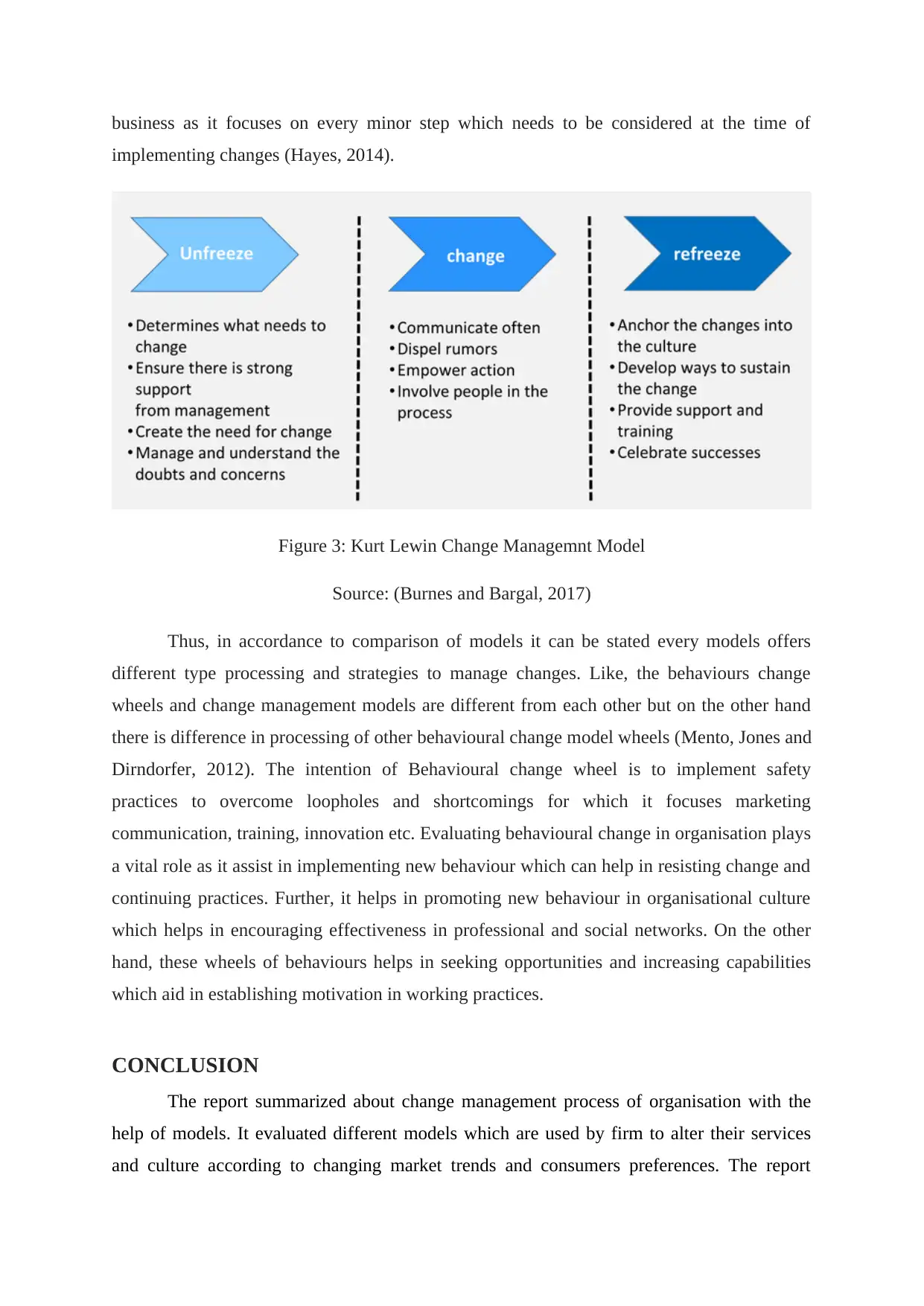
business as it focuses on every minor step which needs to be considered at the time of
implementing changes (Hayes, 2014).
Figure 3: Kurt Lewin Change Managemnt Model
Source: (Burnes and Bargal, 2017)
Thus, in accordance to comparison of models it can be stated every models offers
different type processing and strategies to manage changes. Like, the behaviours change
wheels and change management models are different from each other but on the other hand
there is difference in processing of other behavioural change model wheels (Mento, Jones and
Dirndorfer, 2012). The intention of Behavioural change wheel is to implement safety
practices to overcome loopholes and shortcomings for which it focuses marketing
communication, training, innovation etc. Evaluating behavioural change in organisation plays
a vital role as it assist in implementing new behaviour which can help in resisting change and
continuing practices. Further, it helps in promoting new behaviour in organisational culture
which helps in encouraging effectiveness in professional and social networks. On the other
hand, these wheels of behaviours helps in seeking opportunities and increasing capabilities
which aid in establishing motivation in working practices.
CONCLUSION
The report summarized about change management process of organisation with the
help of models. It evaluated different models which are used by firm to alter their services
and culture according to changing market trends and consumers preferences. The report
implementing changes (Hayes, 2014).
Figure 3: Kurt Lewin Change Managemnt Model
Source: (Burnes and Bargal, 2017)
Thus, in accordance to comparison of models it can be stated every models offers
different type processing and strategies to manage changes. Like, the behaviours change
wheels and change management models are different from each other but on the other hand
there is difference in processing of other behavioural change model wheels (Mento, Jones and
Dirndorfer, 2012). The intention of Behavioural change wheel is to implement safety
practices to overcome loopholes and shortcomings for which it focuses marketing
communication, training, innovation etc. Evaluating behavioural change in organisation plays
a vital role as it assist in implementing new behaviour which can help in resisting change and
continuing practices. Further, it helps in promoting new behaviour in organisational culture
which helps in encouraging effectiveness in professional and social networks. On the other
hand, these wheels of behaviours helps in seeking opportunities and increasing capabilities
which aid in establishing motivation in working practices.
CONCLUSION
The report summarized about change management process of organisation with the
help of models. It evaluated different models which are used by firm to alter their services
and culture according to changing market trends and consumers preferences. The report
⊘ This is a preview!⊘
Do you want full access?
Subscribe today to unlock all pages.

Trusted by 1+ million students worldwide
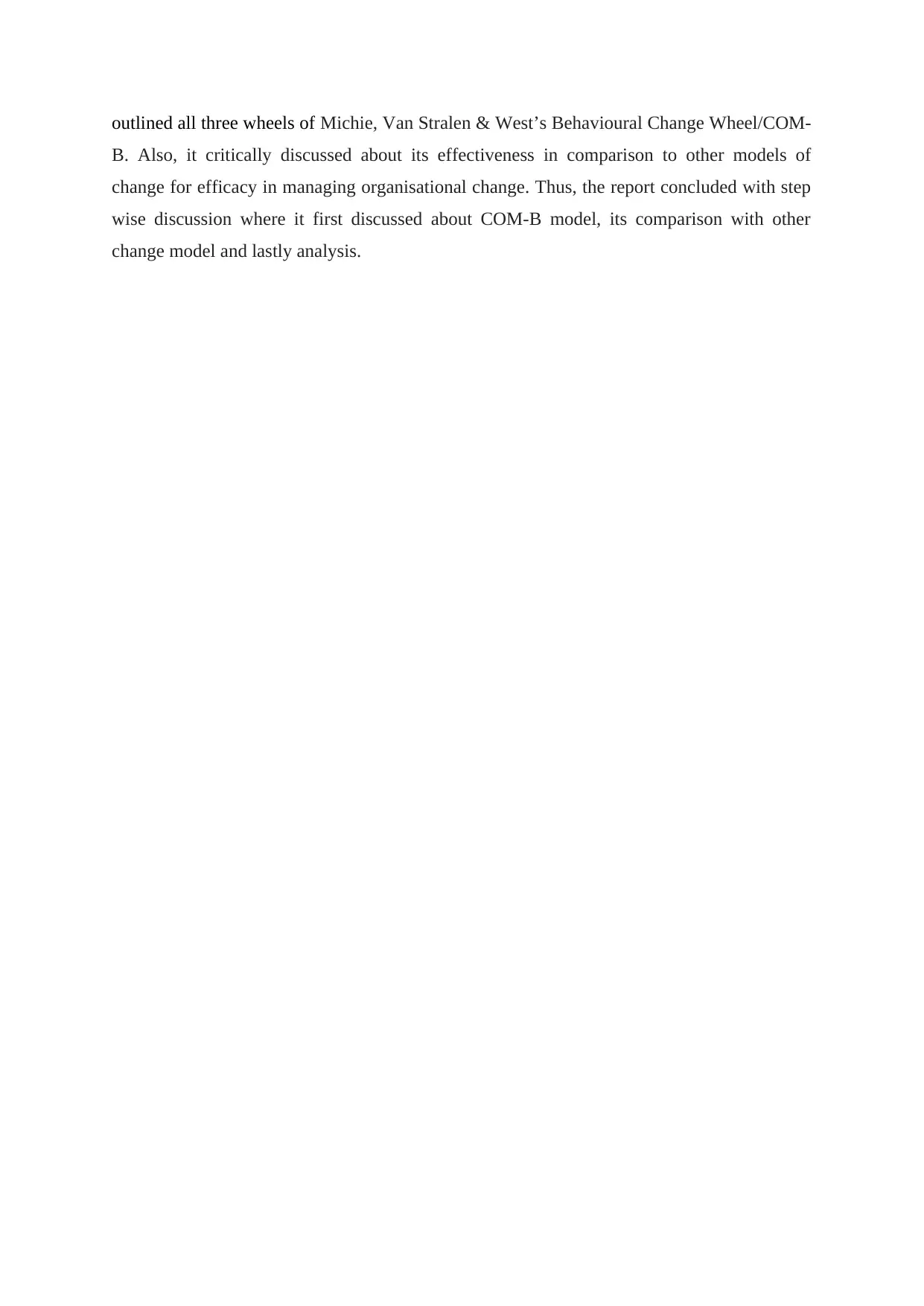
outlined all three wheels of Michie, Van Stralen & West’s Behavioural Change Wheel/COM-
B. Also, it critically discussed about its effectiveness in comparison to other models of
change for efficacy in managing organisational change. Thus, the report concluded with step
wise discussion where it first discussed about COM-B model, its comparison with other
change model and lastly analysis.
B. Also, it critically discussed about its effectiveness in comparison to other models of
change for efficacy in managing organisational change. Thus, the report concluded with step
wise discussion where it first discussed about COM-B model, its comparison with other
change model and lastly analysis.
Paraphrase This Document
Need a fresh take? Get an instant paraphrase of this document with our AI Paraphraser
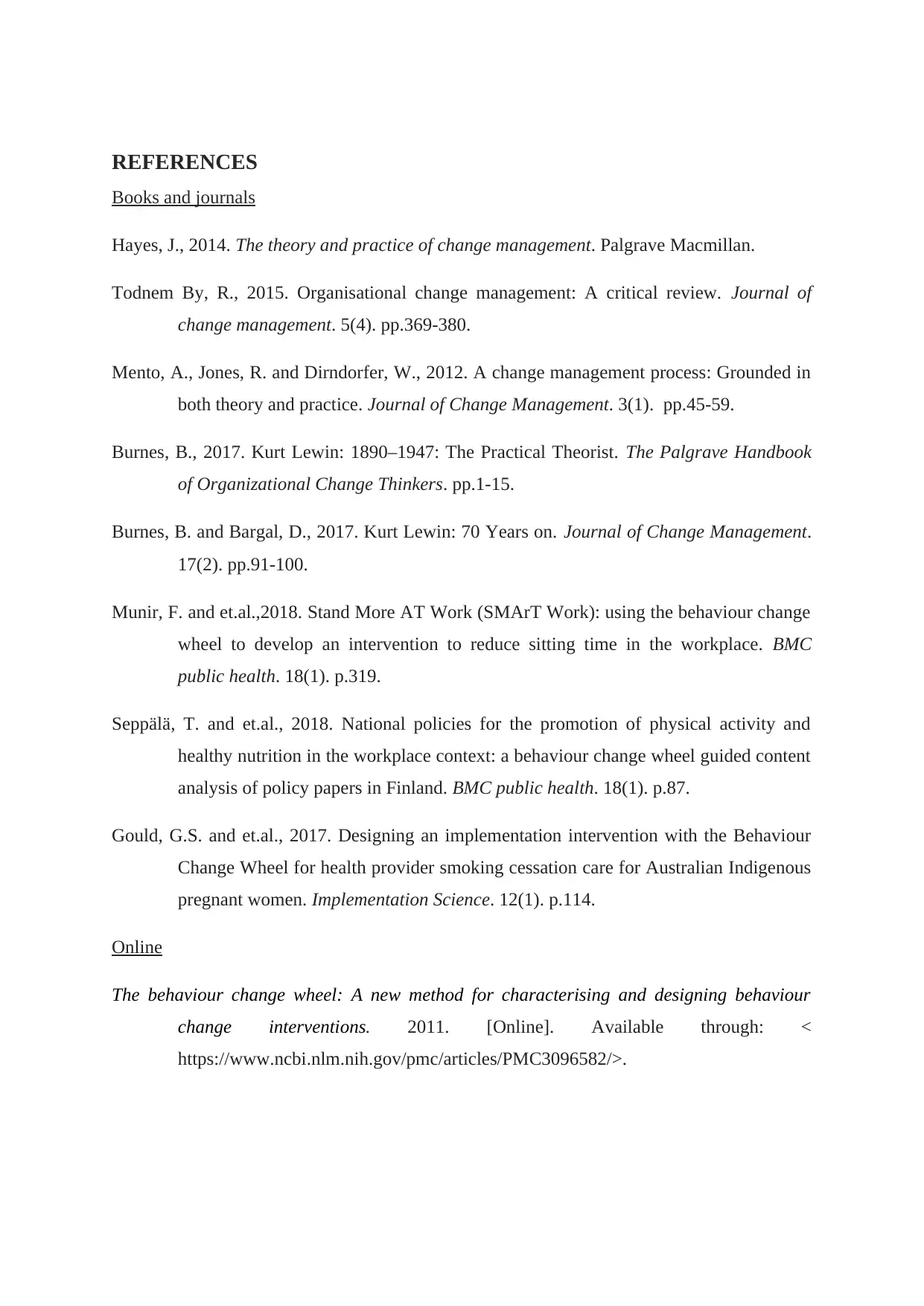
REFERENCES
Books and journals
Hayes, J., 2014. The theory and practice of change management. Palgrave Macmillan.
Todnem By, R., 2015. Organisational change management: A critical review. Journal of
change management. 5(4). pp.369-380.
Mento, A., Jones, R. and Dirndorfer, W., 2012. A change management process: Grounded in
both theory and practice. Journal of Change Management. 3(1). pp.45-59.
Burnes, B., 2017. Kurt Lewin: 1890–1947: The Practical Theorist. The Palgrave Handbook
of Organizational Change Thinkers. pp.1-15.
Burnes, B. and Bargal, D., 2017. Kurt Lewin: 70 Years on. Journal of Change Management.
17(2). pp.91-100.
Munir, F. and et.al.,2018. Stand More AT Work (SMArT Work): using the behaviour change
wheel to develop an intervention to reduce sitting time in the workplace. BMC
public health. 18(1). p.319.
Seppälä, T. and et.al., 2018. National policies for the promotion of physical activity and
healthy nutrition in the workplace context: a behaviour change wheel guided content
analysis of policy papers in Finland. BMC public health. 18(1). p.87.
Gould, G.S. and et.al., 2017. Designing an implementation intervention with the Behaviour
Change Wheel for health provider smoking cessation care for Australian Indigenous
pregnant women. Implementation Science. 12(1). p.114.
Online
The behaviour change wheel: A new method for characterising and designing behaviour
change interventions. 2011. [Online]. Available through: <
https://www.ncbi.nlm.nih.gov/pmc/articles/PMC3096582/>.
Books and journals
Hayes, J., 2014. The theory and practice of change management. Palgrave Macmillan.
Todnem By, R., 2015. Organisational change management: A critical review. Journal of
change management. 5(4). pp.369-380.
Mento, A., Jones, R. and Dirndorfer, W., 2012. A change management process: Grounded in
both theory and practice. Journal of Change Management. 3(1). pp.45-59.
Burnes, B., 2017. Kurt Lewin: 1890–1947: The Practical Theorist. The Palgrave Handbook
of Organizational Change Thinkers. pp.1-15.
Burnes, B. and Bargal, D., 2017. Kurt Lewin: 70 Years on. Journal of Change Management.
17(2). pp.91-100.
Munir, F. and et.al.,2018. Stand More AT Work (SMArT Work): using the behaviour change
wheel to develop an intervention to reduce sitting time in the workplace. BMC
public health. 18(1). p.319.
Seppälä, T. and et.al., 2018. National policies for the promotion of physical activity and
healthy nutrition in the workplace context: a behaviour change wheel guided content
analysis of policy papers in Finland. BMC public health. 18(1). p.87.
Gould, G.S. and et.al., 2017. Designing an implementation intervention with the Behaviour
Change Wheel for health provider smoking cessation care for Australian Indigenous
pregnant women. Implementation Science. 12(1). p.114.
Online
The behaviour change wheel: A new method for characterising and designing behaviour
change interventions. 2011. [Online]. Available through: <
https://www.ncbi.nlm.nih.gov/pmc/articles/PMC3096582/>.
1 out of 11
Related Documents
Your All-in-One AI-Powered Toolkit for Academic Success.
+13062052269
info@desklib.com
Available 24*7 on WhatsApp / Email
![[object Object]](/_next/static/media/star-bottom.7253800d.svg)
Unlock your academic potential
Copyright © 2020–2025 A2Z Services. All Rights Reserved. Developed and managed by ZUCOL.





